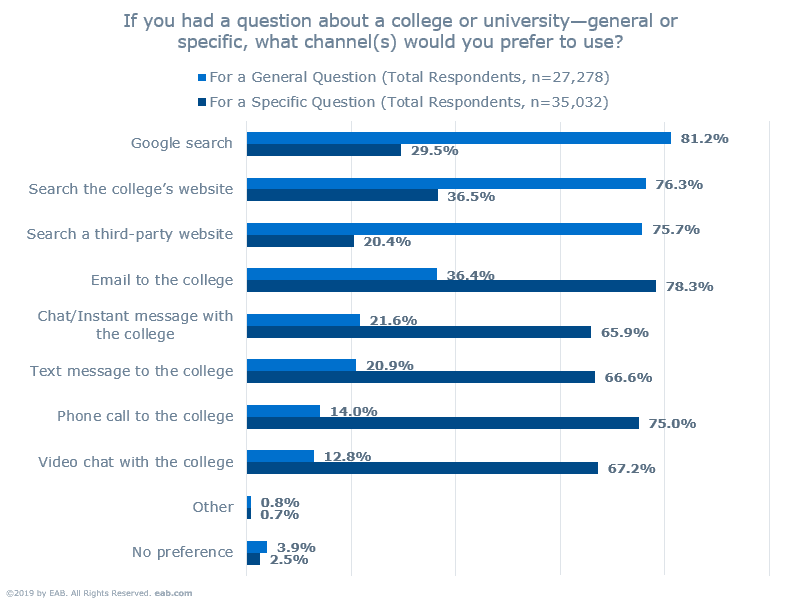Paid search 101: What enrollment leaders need to know
Our work with enrollment teams has shown that paid search can be an effective way to stand out in a space that’s never been more competitive. As more enrollment shops are starting to consider paid search efforts, we thought we’d outline some key paid search concepts, define some terms, and provide some context around paid search for colleges and universities.
According to our latest EAB Student Communication Preferences survey, 92.4% of non-freshman high school students use Internet research to get information on college options. In fact, the survey showed Google search was the most preferred information source for questions about a college or university, as you can see in the chart below.

Considering how much high school students rely on search results for information, we recommend that enrollment leaders stay up to speed on newer trends within the college search landscape, especially paid search advertising.
Why paid search matters in 2020
It’s not just that students rely on the results of Google search for information. Google search advertising plays an important reinforcing role in the student’s fact-finding journey.
EAB analysis shows that as of 2018, stealth applicants — applicants whose first interaction with your school is the submission of an application — make up about 37% of an applicant pool. Since these students do the bulk of their research independently, it’s essential for your brand to appear consistently throughout their journey.
31%
After people have been exposed to your ads on display channels, they often Google your website. As a result, conversion rates on Google ads tend to be much higher than other platforms. According to a survey conducted by Education Dynamics, 31% of students say they remembered seeing paid search ads.
Paid search, as opposed to organic search, also allows you to control the brand experience for a given search query. You can hand-select what type of search terms are important to you and make sure your brand and programs are front and center.
Read on for an orientation to paid search vocabulary and concepts, and how you can get the most out of your efforts as you embark on your own paid search journey.
Paid search terminology
Let’s define some terms and concepts common in the paid search world: some that may be familiar, but others that are certainly technical.
A term that advertisers bid on to trigger their paid search ads to be shown to relevant users. Keywords can be one word, a few words, or a phrase containing several words.
A query is the actual text that a user enters into a search engine.
A group of keywords associated with a set of ads.
A collection of ad groups.
Also known as the destination URL. When an ad is clicked, this is the page to which a user is redirected.
Search Engine Results Pages, the results pages that users get after entering a query into the search bar
Search Engine Marketing, a type of Internet marketing in which websites are promoted by increasing their visibility in SERPs. This is done primarily through paid advertising.
Search Engine Optimization, the practice of improving organic (non-paid) search engine results by curating content, managing page and site structure, and inbound and outbound links.
Branded terms, or branded keywords, are search words or phrases that include a school’s brand name or some variation of it. These can be short tail: “X University” or longtail, including additional terms to offer more specificity and relevance to searchers: “X University financial aid.”
Non-branded terms, or non-branded keywords, are search terms that don’t include your brand’s name, rather an area of interest under which your brand falls. For example, the query, “colleges in New York” may describe your college or university, but other schools also fall under that description. Good SEO can help your school rank higher in searches like these.
The anatomy of a well-executed paid search campaign
Paid search can be an effective way to engage students, but also can become expensive very quickly, so strong planning and rigorous management are important. In our experience, a successful paid search campaign starts with identifying your desired audience (through targeting) and determining the goals of the campaign. Consider the following best practices when making targeting decisions:
- Geography (including your key markets)
- Demographics (focusing on the right age range)
- Audiences (identifying new audiences, lookalike audiences, remarketing audiences, or uploaded student lists)
- Device (ex: mobile vs. desktop)
- Search Terms (specific or broad)
After you answer those questions, there are some metrics to consider that will indicate the success of a paid search campaign. If you have a paid search initiative in place, you need a system of collection and analysis for these metrics.
- Impression: An impression is when a searcher is exposed to one of your ads. The more impressions a campaign yields, the higher the probability that some of those impressions will convert.
- Click: When a user clicks on an ad and is redirected to your landing page. Clicks are both an indicator of traffic and are valuable for tracking campaign effectiveness and overall ROI.
- Cost per click: Costs divided by the number of clicks
- Clickthrough rate: Clicks divided by impressions
Effective paid search should complement organic (unpaid) search
Stay up-to-date
Receive the latest research and insights
Sign UpQuality paid search marketing is great to have, but works best when incorporated into a larger multichannel effort.
The bulk of your traffic will be organic, but organic traffic can land the searcher in multiple places. As a result, paid search is a great way drive specific search action to a desired page. For example, say a prospective student searches “engineering degree.” Your school could be early in the results but would likely take the searcher to a program page with an overwhelming amount of information.
With paid search, your school can bid on that term, appear near the top of search results, and point directly to a landing page that gives less plentiful — but more relevant — information and asks for the student’s information. This is a powerful method used by schools trying to increase inquiry generation.
Given Gen Z’s proclivity for searching for schools online, paid search is an increasingly important element of recruitment marketing. Paid search is a great driver of new-source leads and can be used to reach both Gen Z students and their parents to maximize your school’s visibility during a time when doing so has never been more important.
Next, review these resources
More Blogs

What enrollment leaders can learn from Alabama’s statewide direct admissions program

Is your yield rate okay?
